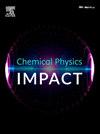Microwave-assisted synthesis and swelling behavior of poly lactic acid (PLA) grafted Cordia dichotoma gum-based hydrogels
IF 3.8
Q2 CHEMISTRY, PHYSICAL
引用次数: 0
Abstract
GBHs, or gum-based hydrogels, or superabsorbents, are derived from natural gums. In their unmodified form, these natural polysaccharides may be limited in their application due to physical matrix erosion caused by intensive swelling. Therefore, tailoring their structure to achieve desired swelling properties is crucial. In this study, a biodegradable gum (CDG) was extracted from Cordia dichotoma fruits using ethanol, and its corresponding grafted copolymer aka CDG-g-PLA was synthesized for the first time by graft copolymerization of poly (lactic acid) (PLA) onto the backbone of CDG by exposure to microwave irradiation. The synthesized CDG-g-PLA copolymer was characterized by FTIR, SEM, XRD, TGA, DSC, and DLS measurements to study its physico-chemical properties. The FTIR analysis proved the grafting of PLA at the –OH group on the backbone of CDG biopolymer which was supported by all other characterizations. The XRD patterns showed a broad peak at 2θ = 26.4 for CDG-g-PLA confirming its amorphous nature. DLS measurements exhibited that particles in the CDG and CDG-g-PLA copolymer formed a coarse suspension in water with particle sizes > 1 µm. The negative value of zeta potential results confirmed the hydrogels to be anionic. The swelling of CDG-g-PLA in water was measured and found to be significantly lower than CDG, making them novel candidates for drug-delivery and sustainable food packaging applications.

微波辅助合成聚乳酸(PLA)接枝天竺葵胶基水凝胶及其溶胀行为
GBHs,或牙龈基水凝胶,或高吸收剂,是从天然牙龈中提取的。在其未经改性的形式下,这些天然多糖可能由于剧烈膨胀引起的物理基质侵蚀而限制其应用。因此,调整其结构以达到所需的膨胀性能至关重要。本研究以乙醇为原料提取了一种可生物降解树胶(CDG),并通过微波辐照将聚乳酸(PLA)接枝到CDG的骨架上,首次合成了相应的接枝共聚物CDG-g-PLA。采用FTIR、SEM、XRD、TGA、DSC、DLS等测试手段对合成的CDG-g-PLA共聚物进行了表征,研究了其理化性质。FTIR分析证实了聚乳酸在CDG生物聚合物骨架上-OH基团的接枝,这得到了所有其他表征的支持。XRD谱图显示CDG-g-PLA在2θ = 26.4处有一个宽峰,证实了其非晶态性质。DLS测量表明,CDG和CDG-g- pla共聚物中的颗粒在水中形成粒径为>的粗悬浮;1µm。zeta电位的负值证实了水凝胶是阴离子的。测量了CDG-g- pla在水中的膨胀,发现其明显低于CDG,使其成为药物输送和可持续食品包装应用的新候选物。
本文章由计算机程序翻译,如有差异,请以英文原文为准。
求助全文
约1分钟内获得全文
求助全文
来源期刊

Chemical Physics Impact
Materials Science-Materials Science (miscellaneous)
CiteScore
2.60
自引率
0.00%
发文量
65
审稿时长
46 days
 求助内容:
求助内容: 应助结果提醒方式:
应助结果提醒方式:


